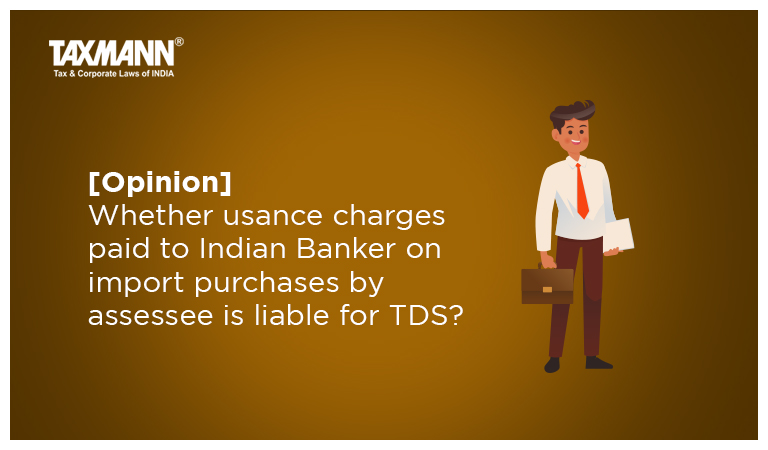[Opinion] Whether usance charges paid to Indian Banker on import purchases by assessee is liable for TDS?
- Blog|News|Income Tax|
- 3 Min Read
- By Taxmann
- |
- Last Updated on 6 August, 2022

Mukesh Kohli – [2022] 141 taxmann.com 112 (Article)
What is Usance Charges?
Usance means the allowable period of time permitted by customs between the date of bill and its payment. The usance of a bill varies between countries. The charges paid for usance period are called usance charges.
Whether Usance Charges is Interest?
Whether importer is liable to deducted Tax under section 195 and payment made for usance charges?
As per Section 195(1) of the Income Tax Act Any person responsible for paying to a non-resident, not being a company, or to a foreign company, any interest (not being interest referred to in section 194LB or section 194LC) (or section 194LD) or any other sum chargeable under the provisions of this Act (not being income chargeable under the head “Salaries”) shall, at the time of credit of such income to the account of the payee or at the time of payment thereof in cash or by the issue of a cheque or draft or by any other mode, whichever is earlier, deduct income-tax thereon at the rates in force:
[Provided that in the case of interest payable by the Government or a public sector bank within the meaning of clause (23D) of section 10 or a public financial institution within the meaning of that clause, deduction of tax shall be made only at the time of payment thereof in cash or by the issue of a cheque or draft or by any other mode.]
[Explanation 1.—For the purposes of this section, where any interest or other sum as aforesaid is credited to any account, whether called “Interest Payable Account” or “Suspense Account” or by any other name, in the books of account of the person liable to pay such income, such crediting shall be deemed to be credit of such income to the account of the payee and the provisions of this section shall apply accordingly.]
[Explanation 2.—For the removal of doubts, it is hereby clarified that the obligation to comply with sub-section (1) and to make deduction thereunder applies and shall be deemed to have always applied and extends and shall be deemed to have always extended to all persons, resident or non-resident, whether or not the non-resident person has—
| (i) | a residence or place of business or business connection in India; or |
| (ii) | any other presence in any manner whatsoever in India.]” |
Though Usance charges may be paid to the Indian bankers by way of LC Charges and commission, nevertheless, such payment, is a part of the transaction involving purchase/import of raw material from non-residents.
Click Here To Read The Full Article
Disclaimer: The content/information published on the website is only for general information of the user and shall not be construed as legal advice. While the Taxmann has exercised reasonable efforts to ensure the veracity of information/content published, Taxmann shall be under no liability in any manner whatsoever for incorrect information, if any.

Taxmann Publications has a dedicated in-house Research & Editorial Team. This team consists of a team of Chartered Accountants, Company Secretaries, and Lawyers. This team works under the guidance and supervision of editor-in-chief Mr Rakesh Bhargava.
The Research and Editorial Team is responsible for developing reliable and accurate content for the readers. The team follows the six-sigma approach to achieve the benchmark of zero error in its publications and research platforms. The team ensures that the following publication guidelines are thoroughly followed while developing the content:
- The statutory material is obtained only from the authorized and reliable sources
- All the latest developments in the judicial and legislative fields are covered
- Prepare the analytical write-ups on current, controversial, and important issues to help the readers to understand the concept and its implications
- Every content published by Taxmann is complete, accurate and lucid
- All evidence-based statements are supported with proper reference to Section, Circular No., Notification No. or citations
- The golden rules of grammar, style and consistency are thoroughly followed
- Font and size that’s easy to read and remain consistent across all imprint and digital publications are applied



 CA | CS | CMA
CA | CS | CMA
